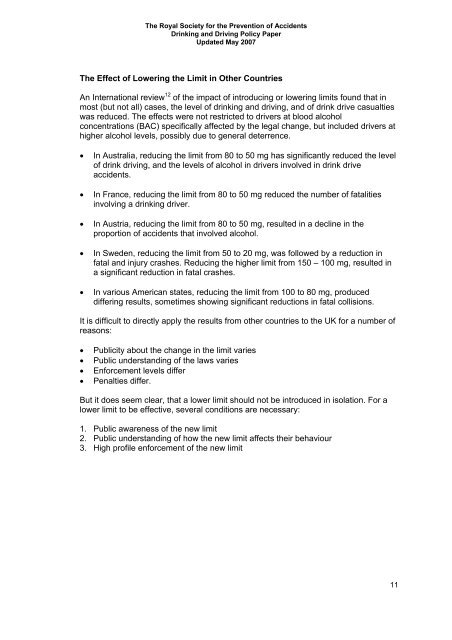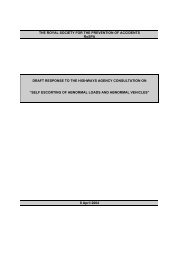RoSPA Drinking and Driving Policy Paper 2007
RoSPA Drinking and Driving Policy Paper 2007
RoSPA Drinking and Driving Policy Paper 2007
You also want an ePaper? Increase the reach of your titles
YUMPU automatically turns print PDFs into web optimized ePapers that Google loves.
The Royal Society for the Prevention of Accidents<br />
<strong>Drinking</strong> <strong>and</strong> <strong>Driving</strong> <strong>Policy</strong> <strong>Paper</strong><br />
Updated May <strong>2007</strong><br />
The Effect of Lowering the Limit in Other Countries<br />
An International review 12 of the impact of introducing or lowering limits found that in<br />
most (but not all) cases, the level of drinking <strong>and</strong> driving, <strong>and</strong> of drink drive casualties<br />
was reduced. The effects were not restricted to drivers at blood alcohol<br />
concentrations (BAC) specifically affected by the legal change, but included drivers at<br />
higher alcohol levels, possibly due to general deterrence.<br />
• In Australia, reducing the limit from 80 to 50 mg has significantly reduced the level<br />
of drink driving, <strong>and</strong> the levels of alcohol in drivers involved in drink drive<br />
accidents.<br />
• In France, reducing the limit from 80 to 50 mg reduced the number of fatalities<br />
involving a drinking driver.<br />
• In Austria, reducing the limit from 80 to 50 mg, resulted in a decline in the<br />
proportion of accidents that involved alcohol.<br />
• In Sweden, reducing the limit from 50 to 20 mg, was followed by a reduction in<br />
fatal <strong>and</strong> injury crashes. Reducing the higher limit from 150 – 100 mg, resulted in<br />
a significant reduction in fatal crashes.<br />
• In various American states, reducing the limit from 100 to 80 mg, produced<br />
differing results, sometimes showing significant reductions in fatal collisions.<br />
It is difficult to directly apply the results from other countries to the UK for a number of<br />
reasons:<br />
• Publicity about the change in the limit varies<br />
• Public underst<strong>and</strong>ing of the laws varies<br />
• Enforcement levels differ<br />
• Penalties differ.<br />
But it does seem clear, that a lower limit should not be introduced in isolation. For a<br />
lower limit to be effective, several conditions are necessary:<br />
1. Public awareness of the new limit<br />
2. Public underst<strong>and</strong>ing of how the new limit affects their behaviour<br />
3. High profile enforcement of the new limit<br />
11
















